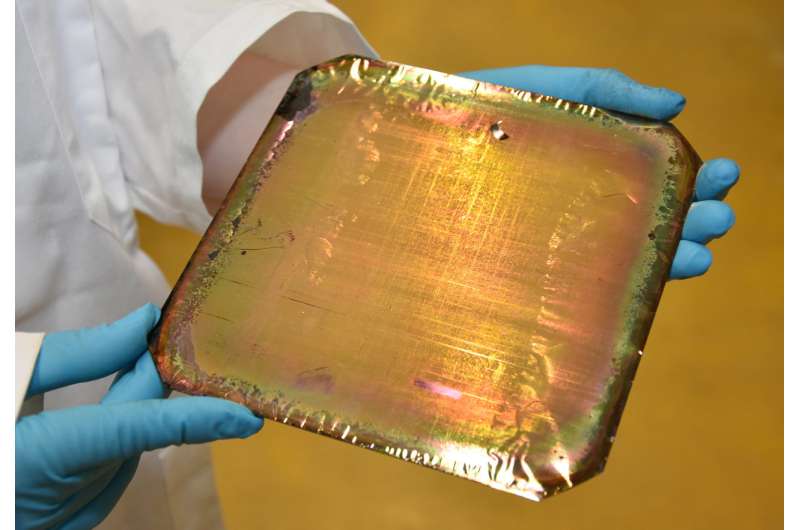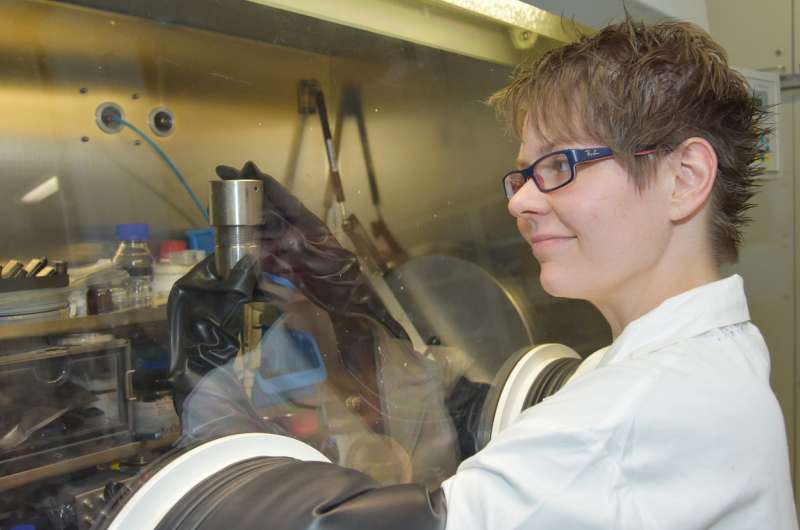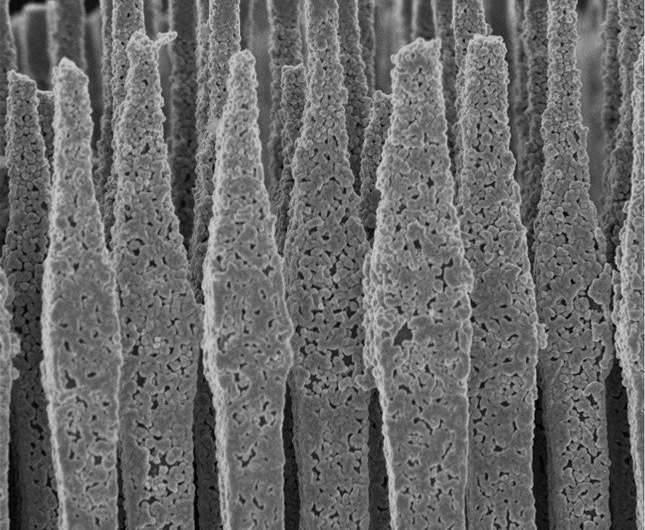Silicon as a new storage material for the batteries of the future

Longer life times, larger ranges and faster recharging—developments such as electric mobility or the miniaturisation of electronics require new storage materials for batteries. With its enormous storage capacity, silicon would potentially have decisive advantages over the materials used in commercial available lithium-ion batteries. But due to its mechanical instability, it has so far been almost impossible to use silicon for storage technology. A research team from the Institute for Materials Science at Kiel University, in cooperation with the company RENA Technologies GmbH, is developing anodes made of 100% silicon, as well as a concept for their industrial production. Through targeted structuring of its surface at the micrometer level, the team can fully exploit the storage potential of silicon. This opens up a completely new approach to rechargeable batteries, as well as the energy storage of tomorrow. This week, the partners are presenting the production and potential use of silicon anodes at the Hannover Messe (23 – 27 April), at the CAU booth (Hall 2, C07).
Silicon has long been a potential candidate for the e-lectric mobility, according to materials scientist Dr. Sandra Hansen. "Theoretically, silicon is the best material for anodes in batteries. It can store up to 10 times more energy than graphite anodes in conventional lithium-ion batteries." Electric cars could drive further, smartphone batteries could last longer, and recharging would be significantly faster. An additional advantage of the semiconductor material is its unlimited availability—after all, sand consists largely of silicon dioxide. "Silicon is the second most abundant element on earth after oxygen, and thus an almost unlimited cost-effective resource," said Hansen.
However, so far the life time of silicon anodes was far too short to really use them in chargeable and rechargeable batteries. The reason for this is the high sensitivity of the material. During charging, lithium ions move back and forth between the anode and cathode. Silicon, as the material with the highest energy density, can take up a remarkable number of lithium ions. While doing so, it expands by 400 percent, and would break in the long run.

At the Institute for Materials Science in Kiel, silicon has been researched for almost 30 years. The findings to date, combined with the silicon experience of RENA Technologies GmbH gained from solar technology, should contribute to producing battery anodes made from 100% silicon. This would enable maximum use of their storage potential—anodes in conventional rechargeable batteries contain only approximately 10-15 percent silicon. To pursue this goal, the joint research project "Development and characterisation of large, porous Si film anodes for lithium-sulphur-silicon energy storage" (PorSSi) kicked off last year, which has gained a total of one million Euros in funding from the Federal Ministry of Education and Research (BMBF, more details see below). The result at the end should be a high-performance silicon battery, along with a concept for its cost-effective industrial production.
"The cooperation between Kiel University and RENA is a highly-efficient combination of decades of experience in fundamental research with industrial process and equipment development expertise," emphasised Dr. Holger H. Kühnlein, Senior Vice President of Technology at RENA Technologies GmbH. "In this way, we can transfer the results from university research into industrial applications as soon as possible," added Professor Rainer Adelung, head of the Functional Nanomaterials working group at Kiel University, where many of the discoveries to date about silicon were made. Adelung: "This is real innovation transfer."
"In order to increase the cycling stability of silicon anodes in batteries, we need to understand exactly what happens when they expand while charging," said Hansen. During her Ph.D. thesis, she discovered that silicon behaves much more flexible when it is produced in the form of a thin wire. These findings are now transferred to porous silicon—its free volume leaves more space for expansion. To prevent the contacts with the electrode from breaking, Hansen has co-developed and patented a method for a stable connection between the two. The team wants to manufacture the counterpart to the anode—the cathode—from sulphur. "A sulphur cathode provides the maximum possible storage capacity. So in this project, we combine two materials that promise really high performance from the battery," said Hansen.

Hansen wants to improve the life time of silicon anodes even further, through special quality control during manufacturing: they are produced from a so-called wafer. Using a lithographic etching process, the surface of this flat disc is structured on a nano scale, to give it specific properties. With an enhanced method from the field of solar technology, Hansen then carries out a visual inspection of the surface over a period of time. In this way, it can be determined at which point in the manufacturing process uneven areas have developed on the surface, which reduce the performance of the anode.
"At the moment, this process still takes a long time and is very expensive. If we can manage to transfer it from a silicon wafer to a porous film, we could etch them in just a few minutes," said Hansen. Through the cooperation with RENA, the research findings flow directly into the development of new etching systems. A prototype will be produced in the course of the three-year project period, and installed at the Faculty of Engineering in Kiel.
More information: Sandra Hansen et al. Corset-like solid electrolyte interface for fast charging of silicon wire anodes, Journal of Power Sources (2018). DOI: 10.1016/j.jpowsour.2018.01.085
Sandra Hansen et al. Size-dependent physicochemical and mechanical interactions in battery paste anodes of Si-microwires revealed by Fast-Fourier-Transform Impedance Spectroscopy, Journal of Power Sources (2017). DOI: 10.1016/j.jpowsour.2017.03.025
Sandra Hansen et al. Local Transmittance Measurements as Large Area Diagnostic Tool for the Optimization of Porous Si Foils for Li-Ion Battery Anodes, Journal of The Electrochemical Society (2016). DOI: 10.1149/2.0811614jes
Provided by Kiel University





















